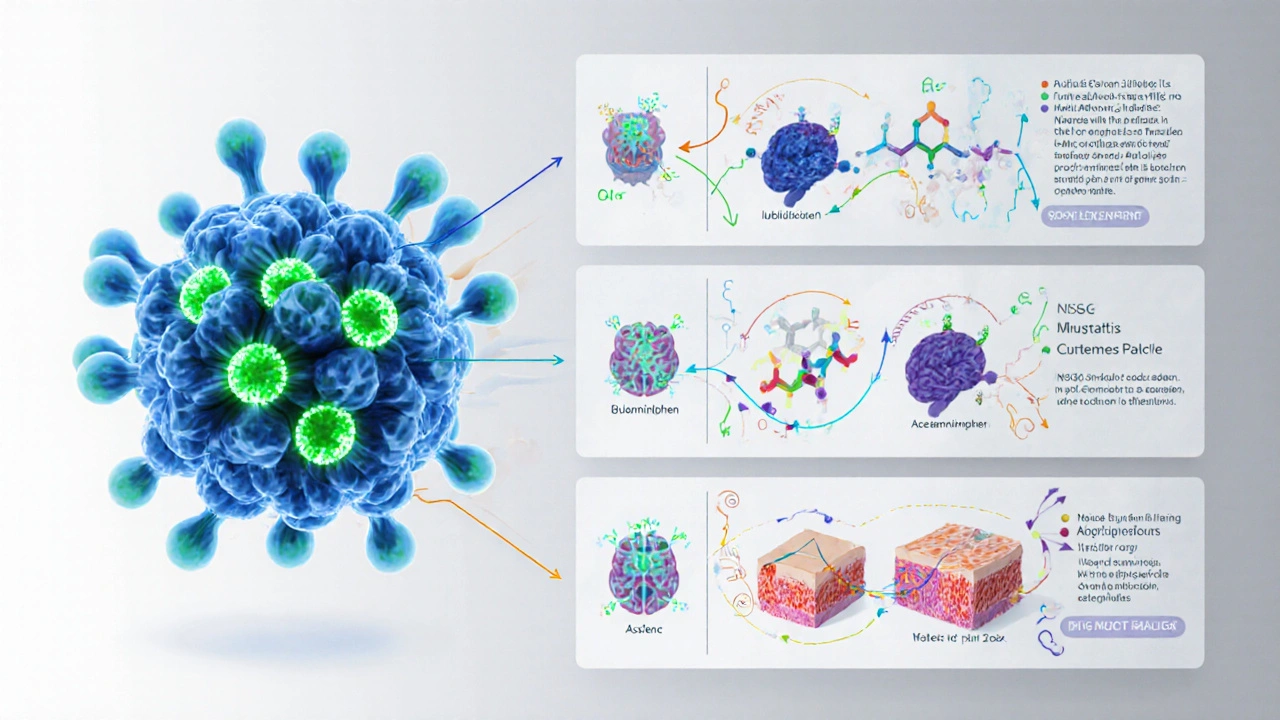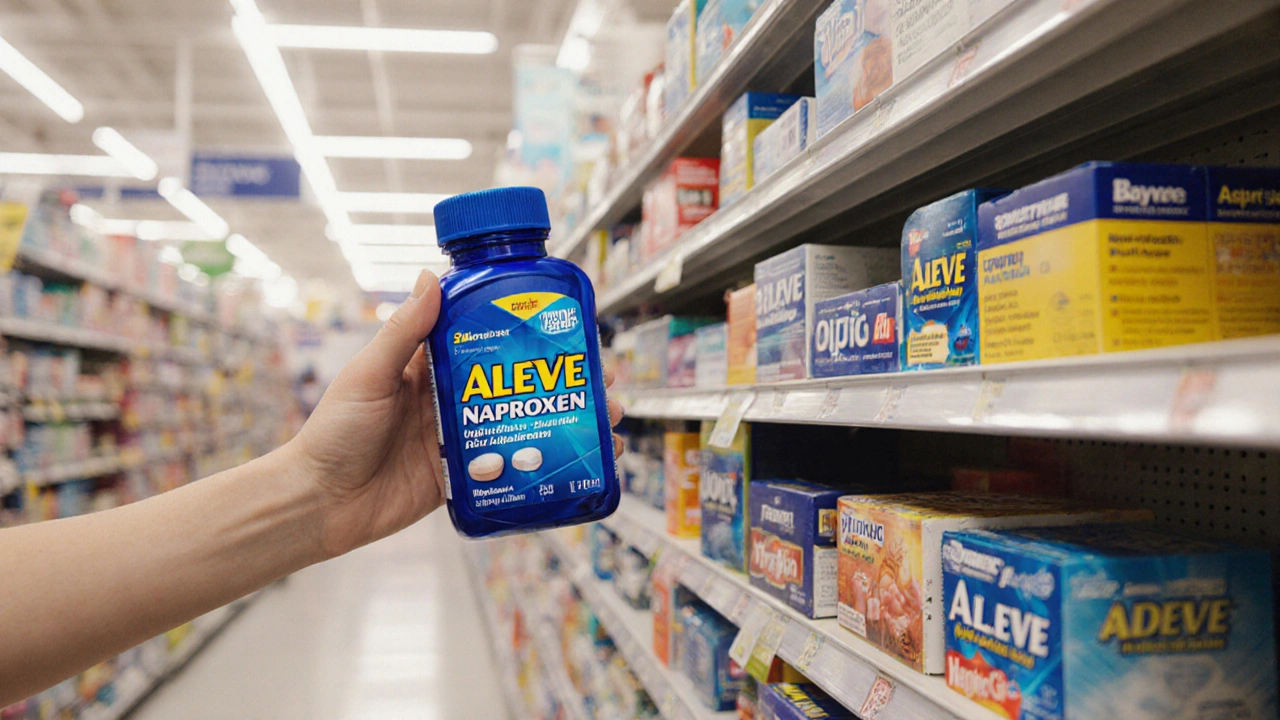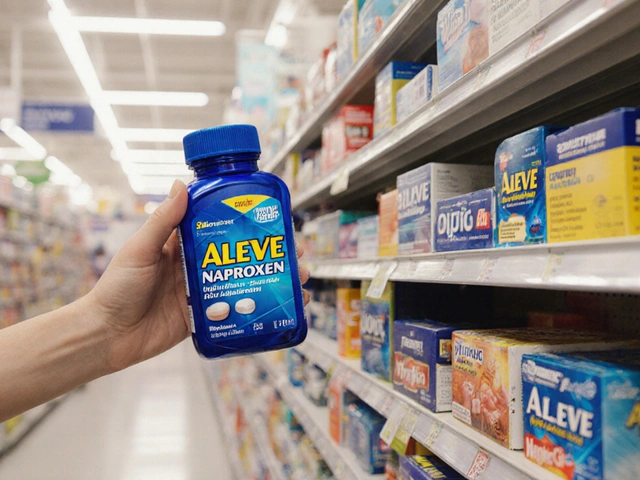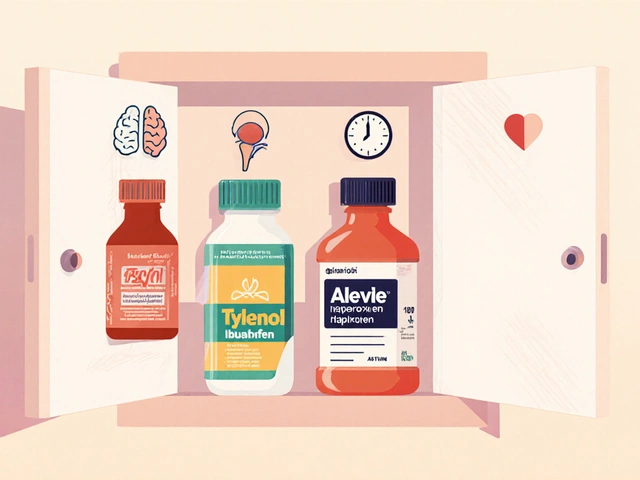When a headache, sore muscle, or joint pain strikes, the first question is often “which OTC pill should I reach for?” Aleve is a household name, but it’s not the only option. This guide breaks down Aleve (naproxen) side‑by‑side with the most common alternatives, so you can pick the one that fits your pain profile, health status, and budget.
What is Aleve (Naproxen)?
Aleve is a brand name for naproxen sodium, a non‑steroidal anti‑inflammatory drug (NSAID) that works by inhibiting the cyclooxygenase (COX) enzymes responsible for producing prostaglandins, the chemicals that cause pain and inflammation. First approved by the FDA in 1976, Aleve’s 220‑mg tablets are marketed for up to 12‑hour relief of headaches, muscle aches, arthritis, and menstrual cramps.
Because naproxen has a relatively long half‑life of about 12‑14hours, you usually only need to take it twice a day, which many users find convenient compared with shorter‑acting NSAIDs.
Key Alternatives at a Glance
The OTC landscape includes several drug classes that address pain in slightly different ways. Below are the primary contenders you’ll see on pharmacy shelves.
- Ibuprofen (brand names: Advil, Motrin) is an NSAID that blocks COX‑1 and COX‑2 but has a shorter duration of action, typically 4‑6hours.
- Acetaminophen (brand name: Tylenol) is not an NSAID; it reduces pain by acting on the brain’s heat‑regulating center and has minimal anti‑inflammatory effect.
- Aspirin (brand: Bayer Aspirin) is an older NSAID that irreversibly inhibits COX‑1, making it useful for cardiovascular protection but also riskier for stomach irritation.
- Diclofenac (OTC version: Cataflam) is a prescription‑strength NSAID that’s been approved for OTC use in low doses for localized pain.
- NSAID (Non‑steroidal anti‑inflammatory drug) is the broader drug class that includes naproxen, ibuprofen, aspirin, and diclofenac, all sharing COX inhibition as their main mechanism.
How They Differ: Detailed Comparison
| Attribute | Aleve (Naproxen) | Ibuprofen | Acetaminophen | Aspirin | Diclofenac |
|---|---|---|---|---|---|
| Active Ingredient | naproxen sodium | ibuprofen | acetaminophen | acetylsalicylic acid | diclofenac sodium |
| Typical OTC Dose | 220mg every 8-12h (max 660mg/24h) | 200mg every 4-6h (max 1200mg/24h) | 500mg every 4-6h (max 3000mg/24h) | 81mg daily (low‑dose) or 250mg every 6-8h (regular) | 25mg topical gel or 25mg oral tablet every 8h |
| Time to Relief | 30-60min | 30-45min | 30-60min | 45-60min | 30-45min |
| Duration of Action | 8-12h | 4-6h | 4-6h | 4-6h | 6-8h (topical) |
| Primary Indications | arthritis, muscular pain, menstrual cramps | headache, toothache, minor injuries | fever, mild‑to‑moderate pain | heart‑attack prevention, inflammatory pain | localized joint or muscle pain |
| GI Bleed Risk | moderate‑high | moderate | low | high (irreversible) | moderate‑high |
| Kidney Impact | potential, especially with dehydration | similar risk | minimal unless overdose | low to moderate | potential |
| Average US Price (per 100mg) | $0.12 (brand) / $0.05 (generic) | $0.08 (brand) / $0.04 (generic) | $0.06 (brand) / $0.03 (generic) | $0.07 (brand) / $0.04 (generic) | $0.10 (gel) / $0.09 (tablet) |
Key takeaways from the table:
- Aleve’s long half‑life means fewer doses, which helps adherence.
- Ibuprofen works faster but requires more frequent dosing.
- Acetaminophen is safest for the stomach but offers no anti‑inflammatory benefit.
- Aspirin’s anti‑platelet effect is a double‑edged sword-great for heart health, risky for GI bleeding.
- Diclofenac’s topical form delivers pain relief directly to the site while limiting systemic exposure.

Choosing the Right Option for Your Needs
Everyone’s pain story is different. Below is a quick decision matrix based on common scenarios.
| Scenario | Best Choice | Why |
|---|---|---|
| Chronic knee arthritis | Aleve (naproxen) | Long‑acting anti‑inflammatory effect reduces dosing frequency. |
| Acute migraine | Ibuprofen | Fast onset and good headache relief. |
| Fever with mild muscle aches | Acetaminophen | Effective fever reducer, gentle on stomach. |
| Post‑surgery pain with risk of blood clots | Aspirin (low‑dose) + acetaminophen | Low‑dose aspirin protects clotting; acetaminophen handles pain. |
| Localized tendonitis | Diclofenac topical gel | Direct application limits GI exposure. |
In any case, reading the label for contraindications-and consulting a pharmacist if you have chronic conditions-is essential.
Safety and Interaction Checklist
All NSAIDs share a core safety profile: they can irritate the stomach lining and affect kidney function. Here’s a quick cheat‑sheet.
- Stomach ulcers or a history of GI bleeding: Prefer acetaminophen or low‑dose aspirin only under doctor guidance.
- Kidney disease or dehydration: Avoid high‑dose naproxen or ibuprofen; stay well‑hydrated if you must use them.
- Blood thinners (e.g., warfarin, apixaban): Skip aspirin and limit NSAID use; check with your prescriber.
- Pregnancy (especially third trimester): Avoid all NSAIDs; acetaminophen is safer.
- Asthma triggered by NSAIDs: Steer clear of naproxen, ibuprofen, and aspirin; acetaminophen is usually safe.
Regulatory oversight comes from the FDA (U.S. Food and Drug Administration), which classifies these drugs as either OTC or prescription based on dose and intended use.

Price and Availability
Price matters, especially when you need a long‑term plan. Generic naproxen costs roughly half of the branded Aleve, making it a budget‑friendly choice for daily arthritis pain. Ibuprofen and acetaminophen are both widely available in generic forms at similar price points. Aspirin is also cheap, but low‑dose “baby aspirin” packages are marketed for heart health rather than pain.
Most major retailers-pharmacies, big‑box stores, and online platforms-carry all five options. Look for bulk packs or store‑brand versions to save up to 30%.
Quick Decision Guide
- Identify your primary symptom: pain, inflammation, fever, or cardiovascular protection.
- Check your health history for stomach, kidney, heart, or pregnancy concerns.
- Match the symptom‑profile to the most suitable drug from the table above.
- Choose the lowest‑cost generic that meets the dosage requirement.
- Read the label for maximum daily dose and any drug‑interaction warnings.
Following these steps usually lands you on the right pill without a trip to the doctor-though you should still see a professional for chronic or severe pain.
Frequently Asked Questions
Can I take Aleve and ibuprofen together?
Generally, combining two NSAIDs doesn’t increase pain relief and raises the risk of stomach bleeding and kidney strain. If you need extra relief, a better approach is to alternate an NSAID with acetaminophen, following the dosing schedule on each label.
Is naproxen safe for people with heart disease?
Naproxen has a slightly lower cardiovascular risk compared with some other NSAIDs, but it’s still not recommended for anyone with uncontrolled hypertension or recent heart events without a doctor’s OK.
How does acetaminophen differ from NSAIDs?
Acetaminophen reduces pain by acting on the brain’s pain‑processing pathways and lowers fever, but it does not block the COX enzymes that cause inflammation. That’s why it’s gentler on the stomach but won’t help swelling.
Can I use aspirin for a headache?
Aspirin can ease tension headaches, but its GI side effects make it a less popular first‑line choice. Many people prefer ibuprofen or acetaminophen for everyday headaches.
What’s the best OTC option for menstrual cramps?
Naproxen (Aleve) is often recommended because its anti‑inflammatory action targets prostaglandin‑driven uterine contractions, and the longer dosing interval fits a typical day‑long cramp cycle.




Charles Markley
October 7, 2025 AT 20:03It is utterly baffling how the layperson continues to conflate naproxen with the entire NSAID class, oblivious to the nuanced pharmacokinetic differentials that dictate dosing intervals. The protracted half‑life of Aleve renders it a pharmacological exemplar of sustained COX inhibition, a property that casual ibuprofen users fail to appreciate. Moreover, the risk–benefit calculus must incorporate gastrointestinal mucosal integrity, a factor conspicuously omitted from popular discourse. One must also consider the ontogeny of renal clearance mechanisms, especially in dehydrated individuals where naproxen accumulation precipitates nephrotoxicity. In sum, the binary choice presented in the article is a disservice to the discerning clinician seeking evidence‑based analgesia.
L Taylor
October 15, 2025 AT 16:56When you stare at the table of drugs you see more than chemicals you see a map of human choices. Each pill is a tiny contract between body and mind a silent pact you sign each morning. The article gives the facts but we must ask why we let pain dictate our philosophy of health. In the end the right choice is the one that aligns with your own lived experience.
Matt Thomas
October 23, 2025 AT 13:50Listen up, the whole “just pick any over‑the‑counter thing” narrative is pure garbage. If you’re not reading the fine print you’re basically signing up for a GI bleed that could’ve been avoided. Naproxen isn’t a magic bullet – it’s a powerful NSAID that can wreck your stomach if you ignore the warnings. So stop being lazy and actually check the label before you pop a pill.
Nancy Chen
October 31, 2025 AT 10:43The pharma giants don’t want you to know that the cheap generics are secretly laced with micro‑doses of “enhancers” to keep you hooked on the brand names. They push Aleve as the “best” while hiding the fact that the same naproxen molecule is in the back‑room shelves of every discount store. It's a classic case of controlled‑substance marketing, designed to keep us dependent on the corporate pipeline. Wake up, read the ingredients, and don’t be a pawn in their profit game.
Jon Shematek
November 8, 2025 AT 07:36Hey folks, don’t let the jargon scare you – you’ve got this! If you need something that lasts through a workday, Aleve’s 12‑hour coverage is a real lifesaver. Got a quick headache? Ibuprofen kicks in fast and gets you back to the grind. Remember, matching the drug to your schedule is the key, so pick the one that fits your hustle and keep crushing those goals.
Beverly Pace
November 16, 2025 AT 04:30While the technical dissection is impressive, we must not lose sight of the human element: unnecessary suffering caused by misguided self‑medication. Ethical stewardship of health means educating patients beyond mere data points.
RALPH O'NEIL
November 24, 2025 AT 01:23Interesting perspective on the philosophical side of pain management. I wonder how individual pain thresholds influence the choice between a long‑acting NSAID and a short‑acting alternative. It could be useful to see some patient‑reported outcomes in future updates.
Mark Wellman
December 1, 2025 AT 22:16Wow, reading that rant really got my blood pumping, like I could feel my veins throb just from the anger.
I’ve been taking naproxen for months and honestly it’s been a mixed bag of relief and dread.
On good days the pain eases and I can actually function without leaning on the coffee machine for support.
But on the bad days the stomach starts growling like a wild beast, and I’m forced to rush to the bathroom, clutching my ribs.
The article’s warning about GI bleed isn’t just a footnote, it’s a real threat that looms over anyone who ignores dosage limits.
I’ve seen friends collapse from kidney issues after binge‑ing NSAIDs during finals week, and that image haunts me.
The bold claim that “just check the label” feels dismissive of the chaos that chronic pain brings to daily life.
There’s a whole psychological component where you feel guilty for taking a pill, yet you’re terrified of the pain returning.
And let’s not forget the financial strain; brand‑name Aleve can drain a student’s budget faster than rent.
Generic naproxen does the job, but the marketing machine makes you think you need the pricey version for “better” relief.
Meanwhile, ibuprofen is tossed around like a cheap fix, but its shorter half‑life forces you into a cycle of constant dosing.
I’ve tried alternating ibuprofen with acetaminophen, and while it works, it feels like juggling a circus of numbers.
The table in the article is helpful, yet it lacks real‑world anecdotes that could guide a weary soul.
Ultimately, the decision rests on balancing efficacy, side‑effects, and personal tolerance, not just reading a chart.
So before you pop the next tablet, think about your gut, your kidneys, and whether you’re ready to live with the trade‑offs that come with each choice.
Amy Morris
December 9, 2025 AT 19:10I hear the frustration and the feeling of being manipulated, and it’s truly heartbreaking when you suspect hidden motives in something as simple as a pain reliever. Your words paint a vivid picture of betrayal, and I hope you find clarity amidst the haze of corporate intrigue.